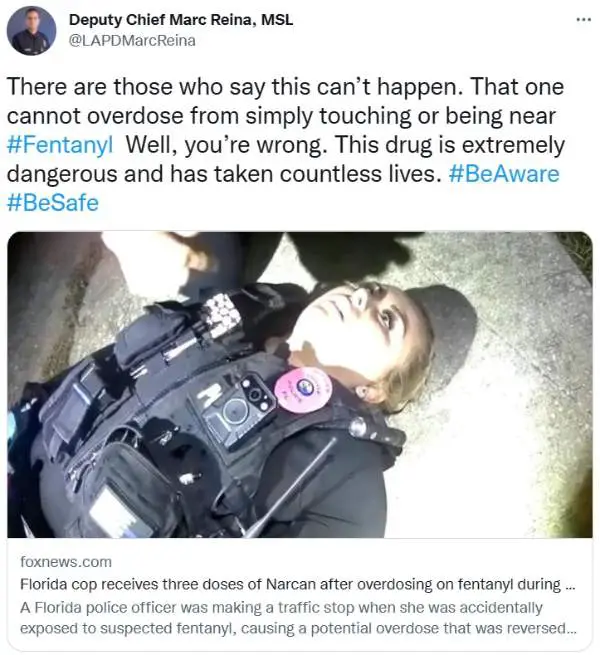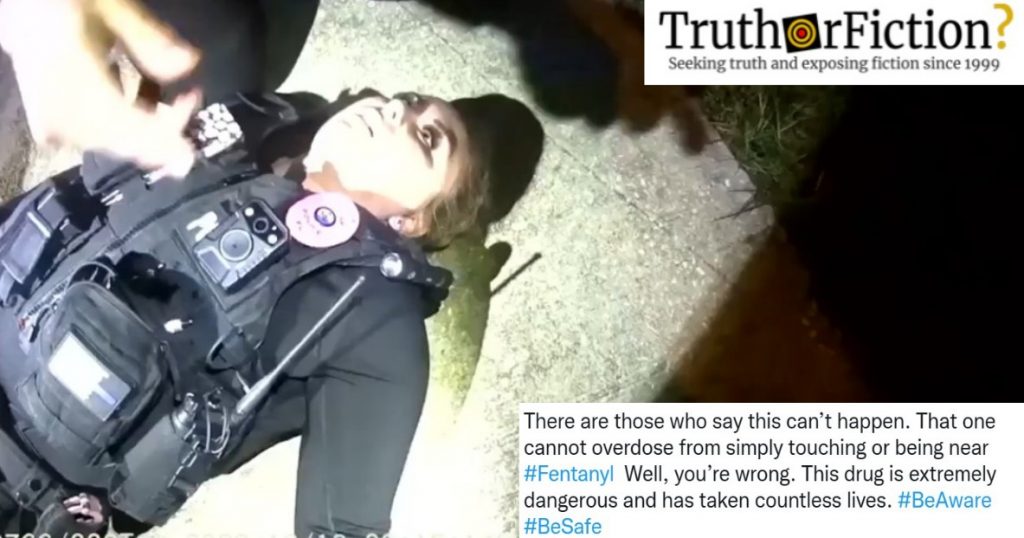A story out of Florida in December 2022 quickly gained traction online and made it to the national spotlight, becoming the latest story to push the claim — contrary to medical expertise — that even brief exposure to fentanyl can induce an overdose.
As is often the case, local television outlets pushed the story first; WESH-TV out of Orlando reported on December 13 that police in nearby Tavares released “difficult-to-watch footage” of officers reviving Officer Courtney Bannick after she allegedly came into contact with the drug.
Fact Check
Claim: Brief exposure to fentanyl can cause an overdose
Description: A story out of Florida in December 2022 pushed a claim that brief exposure to fentanyl can induce an overdose. This story was fueled through various news outlets, despite medical experts consistently stating that being around fentanyl does not cause people to overdose.
Reporter Anika Hope’s feature (listed without a byline on the station’s website) hinged on the footage and just one source, who was identified as Detective Courtney Sullivan; not mentioned in this story was that Sullivan was also the department’s public information officer.
Sullivan claimed that the incident ocurred while Bannick was conducting a traffic stop, during which she “found narcotics on a passenger.” According to WESH:
“Whenever she saw it rolled up in a dollar bill, she noticed that. She just barely opened it and saw that it was narcotics. Closed it quickly,” Sullivan said.
Sullivan said Bannick wore gloves as she always did.
The officers agreed to test the substance back at the department, trying to avoid exposure because it was windy.
“Next thing you know, she was trying to [speak] on the radio and you could hear in the radio traffic almost like she was choking,” Sullivan said.
After allegedly finding Bannick “in and out of consciousness,” WESH reported that fellow officers administered the recuperative drug Narcan. The story included footage of Bannick laying on the ground on her back as an unidentified officer claimed that she was overdosing:

“Officer Bannick really wants others to take away that this drug is dangerous,” Sullivan said. “It’s dangerous for not only yourself but others around you. Something as simple as the wind could expose you and just like that, your life could end.”
After WESH posted the story on its Twitter page, other users referred the station to sources debunking this type of claim, including a thread from emergency room physician and toxicologist Dr. Ryan Marino, who often calls on news outlets to stop sharing fentanyl-related disinformation.
“I watched the video and it’s not an overdose,” Marino wrote. “So not only is it an impossible story, but fentanyl overdose is what we call a ‘clinical diagnosis,’ meaning you can diagnose it based on specific criteria (unresponsiveness, respiratory depression, pinpoint pupils, etc) & this wasn’t.”
Marino is far from alone; as we (and other news organizations) have reported, medical experts have consistently found no evidence that simply being around fentanyl can cause people to overdose.
We have also noted a statement by the American College of Medical Toxicology and the American Academy of Clinical Toxicology rebutting such claims:
Fentanyl and its analogs are potent opioid receptor agonists, but the risk of clinically significant exposure to emergency responders is extremely low. To date, we have not seen reports of emergency responders developing signs or symptoms consistent with opioid toxicity from incidental contact with opioids. Incidental dermal absorption is unlikely to cause opioid toxicity. For routine handling of drug, nitrile gloves provide sufficient dermal protection.
“We took Tavares Police Department at their word — that in fact the officer became overcome with fentanyl based on the fentanyl that was discovered by her in the traffic stop,” a WESH producer told us.
When asked if there was a reason they did not include the clinical consensus on these types of stories, the producer said: “We didn’t pursue it following the release of the video, but we may. We’re seeing how this plays out. Police are conducting their own investigation.”
WESH did air a follow-up story, but only cited Marino and did not acknowledge the rebuttal by the groups of experts mentioned above.
The station’s parent company, NBC News, republished WESH’s piece without any additional context. The network did not respond to a request for comment.
As is also often the case, other nearby news outlets — such as WKMG-TV in Orlando — regurgitated the department’s claims; an assignment editor said that the arguments from experts are “possibly something we can follow next week.” The Miami Herald newspaper included just one line (linking to a New York Times story) about evidence refuting the department’s claims:
Medical authorities have said that incidental contact with fentanyl like this isn’t enough to enter the bloodstream and cause overdose symptoms.
We called five editors at the Miami Herald seeking comment on their reporting process. None responded.
One exception was a story by WFLA-TV in Tampa, which did cite another medical expert — who also refuted the department’s claim:
“The one case in which fentanyl can be absorbed through the skin is with a special doctor-prescribed fentanyl skin patch, and even then, it takes hours of exposure,” said Daniel Colby, an assistant professor and co-medical director for the Department of Emergency Medicine at UC Davis Health.
Sullivan tells WFLA the officer clearly overdosed, otherwise the Narcan wouldn’t have revived her. She said the substance is believed to be fentanyl and that the agency sent it to an FDLE lab for testing.
Sullivan told us in a statement that the department is still investigating the traffic stop that caused the purported overdose. Once that is complete, she said, police would release Bannick’s medical records as well as documentation associated with the case.
The statement also read:
“Not only does the Department trust Officer Bannick; we also know we know her experience is, unfortunately, not unique,” Chief Sarah Coursey said. “Fentanyl exposure is a real and ever-growing threat to first responders. Studies completed years ago do not accurately reflect the strength and risk of current street-level fentanyl.”
While most of the questions revolve around whether a fentanyl overdose can happen through skin contact, it is unclear how Officer Bannick came into contact with the drug. Inhalation due to high winds during the incident is as likely as skin contact.
Sullivan also referred us to advisory posts from the Centers for Disease Control and Prevention (CDC) and the Virginia state government for first responders dealing with fentanyl. But the latter page specifically states:
Skin exposure is NOT likely to lead to toxicity through absorption. However, if your skin is exposed to fentanyl, wash with soap and water as soon as possible and take measures to not touch your face, smoke, eat, or use the bathroom before washing. Alcohol-based hand sanitizers and bleach are not effective at removing opioids from skin, and may increase skin absorption.

The “overdose” story was eventually picked up by right-wing news organizations and further promulgated by law enforcement; the Fox News story was posted by Los Angeles Police Deputy Chief Marc Reina:

“There are those who say this can’t happen,” Reina wrote over a link to the story, featuring a photograph of Bannick. “That one cannot overdose from simply touching or being near #Fentanyl […] Well, you’re wrong. This drug is extremely dangerous and has taken countless lives.”
We contacted the Los Angeles Police Department asking if Reina had any evidence that the officer — several states away — did in fact overdose, whether he was aware that his claim had been thoroughly debunked by medical science, and whether he felt that Fox “reporting” regarding LGBTQ communities and the January 2021 right-wing coup attempt at the U.S. Capitol was also credible. We did not receive a response.
We also contacted newly-elected Los Angeles Mayor Karen Bass seeking comment on Reina’s claim. Her office did not respond. Bass also has yet to respond to our request for comment in June 2022 — when she was still running for office — regarding police attacks on local reporters.
Update, 12/19/2022, 10:22 a.m. PST: Updated to reflect additional reporting by WESH-TV. — ag
- Fact Check-Overdose of Fentanyl Just by Being in its Presence is not Possible, Experts Tell Reuters
- Preventing Occupational Fentanyl and Fentanyl Analog Exposure to Emergency Responders
- Bodycam Shows Florida Officer's Overdose During Drug Search
- VIDEO: Florida Cop Treated for Overdose After Possible Fentanyl Exposure, Police Say
- Fentanyl: Emergency Responders at Risk
- Tavares Police, Medical Experts Address Questions About Officer's Exposure to Fentanyl

